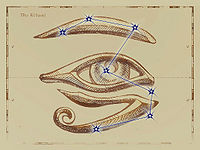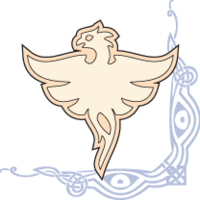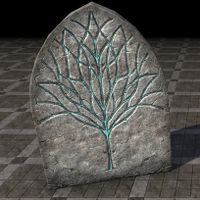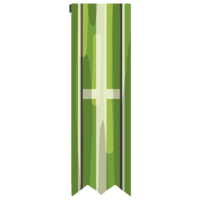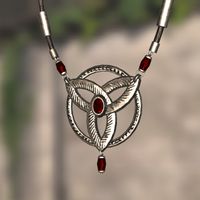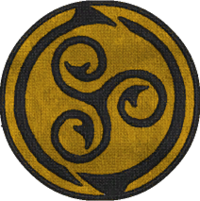Lore:Symbols
| This article is currently undergoing a major expansion or revamping by the author who placed this notice here. However, you are free to help in the construction of this page by improving it—use the talk page to do so. Please review the edit history if you would like to see whether the page is still being worked on. If the editor who placed this notice has not made any changes in a while, please contact the editor or, if they're inactive, remove this template. |
A wide variety of symbols are used throughout Tamriel and beyond. This section illustrates the variety of symbols used.
Symbols[edit]
Anhk[edit]

The anhk [sic][1] is common iconography associated with the architecture of temples throughout Tamriel,[2] as well as the signage of temples throughout the Iliac Bay region.[3] The Moth Priest Kellen wore an anhk shaped amulet.[4]
Aurbic Eye[edit]
The Aurbic Eye is a mystical symbol in the shape of eye, often surrounded by elegant lines and sometimes various scripts. It is named for the Aurbis and symbolizes a connection to the magicka essence of Nirn, and those who wear it emphasize their own anima essence. The symbol is used in the signs of many mage shops and guilds, most notably the Mages Guild and the College of Winterhold. It often shares the same shape as the Ritual constellation.
The College refers to it as the Eye of Shalidor or Eye of Magnus (sharing a name with the artifact), a symbol born from the legacy of Shalidor that looks upon the College with a burning gaze. Those who join the College have Shalidor's magic imprinted on their bodies invisibly, and as they pass trials marks of the Eye gradually begin to appear on them. It is worn on circlets and hoods as a "third" eye, and those who pass the final test during the trials find Shalidor's eye marked across their brow. In the Altmeri lesson of the divine body, the phrase "The Eye of Magnus is always upon us, in the spells and enchantments that devout Mages conjure." is recited by religious preachers.
Aurbic Phoenix[edit]
Phoenixes are mythical creatures present in Altmeri and Bretonic folklore. Little is known about phoenixes except for their intense red plumage. Aurbic Phoenix imagery is associated with the school of Restoration.
Blessed Life-Tree[edit]
The Blessed Life-Tree is a symbol common in Ayleid culture. The brilliant hue of the Ayleid life-tree glows upon those who sought knowledge from the Ayleids.
Reliefs of the life-tree are commonly found in Ayleid ruins. Some who return from endeavors into these ruins return with the markings of the blessed life-tree on their face, seemingly by gaining favor from one of their spirits. It is believed that having these markings can furthermore win the favor of lingering ghosts.
Cross[edit]
The cross is a symbol depicting two intersecting lines, associated with various faiths and used in torture. Crossing ones heart is declaration of honesty. The cross is sometimes used as a symbol of Meridia. The Toxicruciform is a curio associated with Peryite, found in the form of a cross. Tombstones are sometimes carved into the shape of a cross. During the Imperial Simulacrum, monks, priests, and friars all throughout Tamriel were known to wear golden crosses.
Ouroboros[edit]
The Ouroboros is a symbol linked to Satakal, depicted as a circular image portraying a serpent consuming its own tail. Another version of this symbol, featuring three heads resembling an eagle, lion, and dragon, became connected to the Three Banners War.
Red Diamond[edit]
The Red Diamond is the symbol of the Empire, the Septim Dynasty, and the Nine Divines.[5][6][7] It is based on the Chim-el Adabal, the cut red soul gem in the center of the Amulet of Kings.[8][9]
Scarab[edit]
Scarabs are a variety of beetle that have cultural significance in various parts of Tamriel. Scarabs are known to be found in Vvardenfell, and a giant variety has been found underground in Bangkorai. Dung beetles are species of scarab beetle that pick through refuse and collect and roll dung into balls to survive. Dung beetles are sometimes kept as pets, and can be used to clean a dinner table between courses. Assassin Beetles are a large variety of scarab beetle found in Hammerfell and other places. The smaller ancestors of assassin beetles were known to the Yokudans as Samara Scarabs.
Scarabs have significant symbolic and practical importance to the Dunmer. The Black Scarab is the House Symbol of House Redoran and it is considered sacred by its members, their armors are often adorned with the symbol. Scarab elytra are used in the crafting of House Redoran equipment, Redoran shields appear to be fashioned from the overlapping chitin plates of a gigantic scarab.
Triquetra[edit]
The triquetra is an ancient symbol that can be described as a three-sided knot that has been present in many Tamrielic cultures. Evidence of its earliest known usage comes from an Ebony fox totem depicting Shor with the blending of Snow Elf and Atmoran artisan techniques. This totem features the standard triquetra along with a variation of it seen in Snow Elf equipment. However, the symbol is most commonly used by the Bretons in the modern day. The origins of Bretonic usage dates back to around 1E 330 on the Systres Archipelago: the Druids of Galen dissolved due to a religious schism and split into the Stonelore, Eldertide, and Firesong Circles. The three druidic circles thus began shaping knot-work into the triquetra, to symbolize their shared goals and ultimate unity. When mainland Bretons adopted the triquetra is unknown, but today it can be found emblazoned on many things associated with Bretons, such as their armor, weapons, furniture, and clothing.
Triskelion[edit]
The triskelion is a symbol consisting of three interlocked spirals radiating from a common center. The triskelion is characterized by its triple spiral structure. It holds significance in various cultures and religions, including those of the Bretons, Bosmer, Nords, and Reachfolk.
Notes[edit]
- A symbol identical to the fluer-de-lis appears in games since Daggerfall, though it is never named.
- In Daggerfall, the fleur-de-lis can be seen alongside the Kingdom of Daggerfall's dragon logo.
- In ESO, the fluer-de-lis can be seen on Imperial armor, such as the West Weald Legion Style armor. It can also be found in Breton things like the House Dufort Banneret Style and the Order of the Albatross banner. It is also present on the light Hollowjack Style.
- The UK cover for Daggerfall displays papers that feature many random symbols such as the Seal of Solomon, musical notes, Urdu script, and Chinese characters, among others.
References[edit]
- ^ Cyrus's dialogue in Redguard
- ^ Temples in the cities in Arena
- ^ Temples in the cities in Daggerfall
- ^ Epilogue mission during The Forgotten Hero
- ^ Empire of Cyrodiil card back in Legends
- ^ Brief History of the Empire v 2 — Stronach k'Thojj III
- ^ Nine Divines faction in Oblivion
- ^ Amulet of Kings in Oblivion
- ^ The Amulet of Kings — Wenengrus Monhona
|
||||||||||||||
